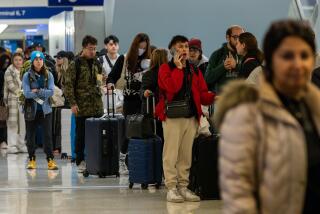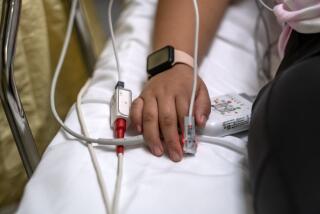Swine flu scare gives hospital a practice run
In the emergency room at Long Beach Memorial Medical Center, where scores of frightened people arrived last week to have their nerves eased and their fevers abated, the triage was simple:
Those complaining of flu symptoms were masked and separated from the rest of the ER patients until they could be further evaluated. Those who were visibly ill were immediately isolated pending tests. Those determined to be the “worried well,” in hospital lingo, were reassured and sent home. It was a choreography of salvation, danced time and again.
It was impossible last week to avoid the sense that swine flu was threatening each and every one of us. The march of news was striking: from a small, unexplained incident of swine flu in Southern California, to an explosion of cases -- and deaths -- in Mexico, then rampaging from one country to the next. Cable news was breathless; newspapers and websites were flooded with information.
Locally, hospitals reported up to 12% more patients in already crowded emergency rooms, according to figures gathered by the Hospital Assn. of Southern California.
But the math also told a different story: To date, confirmed cases in the United States have been few.
By Friday night, Long Beach Memorial, the second-largest not-for-profit hospital west of the Mississippi, had yet to see one confirmed case of swine flu. There have been other illnesses among the patients, to be sure, and some tests are still pending. But the bulk of the time, doctors have been treating fear as much as physical ailments.
“This is a lot of concern and appropriate watchfulness for something that is fortunately turning out to be clinically mild,” said Dr. James D. Leo, the hospital’s associate chief medical officer.
The new flu’s presence has reminded everyone of the basics in hygiene -- wash your hands and cover your coughs, came the dictate from President Obama on down. But it was also a reminder that, in a crunch, lives can depend on preparations carefully worked out years in advance.
The response to last week’s global surge in swine flu owes much to an earlier would-be pandemic, avian flu. Its threat years ago to go global led federal and state officials and hospitals to bolster their disaster plans.
In California, that had concrete repercussions. The 2006-07 state budget included $214 million for preparedness. Purchased were 2,400 ventilators, medical supplies and equipment for 20,000 hospital beds, 50 million masks for healthcare workers and three mobile field hospitals with 220 beds each. Medicine stored in warehouses around the state included 3.7 million doses of antiviral drugs, now being supplemented by millions more from federal stores.
Hospitals also geared up. Long Beach Memorial has had a pandemic influenza plan in effect since 2007. It covers everything from triage specifics, like those being used last week, to how to staff the hospital if a disaster takes down many of its 4,000 employees. This being California, the land of many potential forms of demise, the flu plan is one of several meant to govern the hospital in a time of crisis.
“We drill for earthquakes; we drill bombings, terrorist attacks, pandemic influenza,” Leo said. “It is one of a number of different scenarios.”
The drill became real more than a week ago, with the first inklings of crisis: two cases in the San Diego area. Hospital officials geared up and waited for the influx of patients. They have come, if not the diagnoses.
Had the patients actually suffered from swine flu, the full range of the pandemic plan would have gone into effect. Patients would have been isolated in separate rooms, those treating them garbed in full protective gear. The hospital has its own stores of antiviral medications and supplies, and more would have been obtained from the state if needed. Elective admissions and surgeries would have been curtailed. The hospital would have pared down to its essence.
That has not happened, and no one knows if it ever will. But nonetheless, the last week has been illuminating, Leo said.
“This teaches us a tremendous lesson in terms of how rapidly something like this can develop, from seeming thin air, and be spread,” he said. And it also gives officials a chance to check their plans against reality.
One thing officials there and elsewhere have learned is the need to educate potential patients about their role -- essentially, to be as calm and collected as the hospital staff has been.
“People are hearing enough that they are concerned when they have symptoms,” Leo said. “They come running into the emergency department -- and that’s not necessarily the best thing to do.” Better to call the doctor for mild complaints and save ER visits for more serious symptoms, he said.
Memorial’s experience is hardly singular. Jim Lott, executive vice president of the Hospital Assn. of Southern California, said hospitals have largely spent the week dealing with “anxious people and government officials.”
The subject could come up next month, when California had planned to hold one of its regular disaster drills. As last week ended, a state spokesman said it was unclear whether the drill would take place, or whether hospitals would be too busy to take part.
The subject: pandemic influenza.
Each Sunday, The Week examines one or more of the previous week’s major stories and their implications for our state or region. Previous editions of The Week are archived at latimes.com/theweek.
More to Read
Sign up for Essential California
The most important California stories and recommendations in your inbox every morning.
You may occasionally receive promotional content from the Los Angeles Times.











